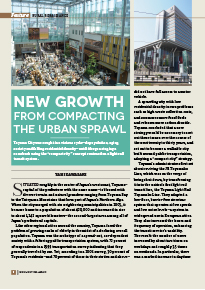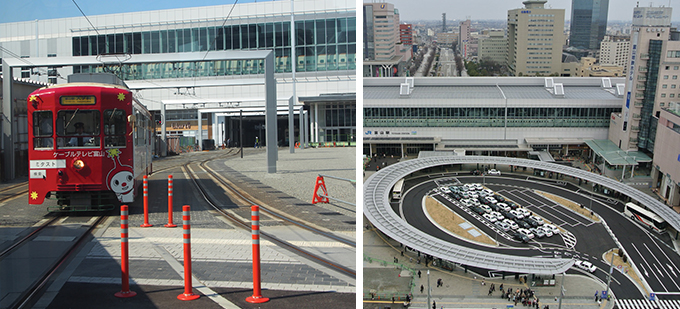Home > Highlighting JAPAN >Highlighting Japan June 2015>Rural Renaissance
Highlighting JAPAN

Rural Renaissance
New Growth from Compacting the Urban Sprawl
Toyama City was caught in a vicious cycle—depopulation, aging society and falling residential density—until it began staging a comeback using the “compact city” concept centered on a light rail transit system. 
Situated roughly in the center of Japan’s west coast, Toyama—capital of the prefecture with the same name—is blessed with diverse terrain and natural grandeur ranging from Toyama Bay to the Tateyama Mountains that form part of Japan’s Northern Alps. When the city merged with six neighboring municipalities in 2005, it became home to a population of about 420,000 and increased in size to about 1,242 square kilometers—the second-largest area among all of Japan’s prefectural capitals.
Like other regional cities around the country, Toyama faced the problem of growing ranks of elderly in the midst of a declining overall population. Toyama was the archetype of a spread-out, car-dependent society with a faltering public transportation system, with 72 percent of respondents in a 1999 transportation survey indicating that they generally traveled by car. Yet, according to a 2006 survey, 30 percent of Toyama’s residents—and 70 percent of those in their sixties and above—did not have full access to a motor vehicle.
A sprawling city with low residential density incurs problems such as high waste collection costs, and consumes more fossil fuels and releases more carbon dioxide. Toyama concluded that a new strategy would be necessary to sort out these issues over the course of the next twenty to thirty years, and set out to become a walkable city built around public transportation, adopting a “compact city” strategy.
Toyama’s administrators first set about reviving the JR Toyamako Line, which was on the verge of being shut down, by transforming it into the nation’s first light rail transit line, the Toyama Light Rail Toyamako Line. They adopted a low-floor, barrier-free streetcar system that operates at low speeds and low noise levels—a system in widespread use in European cities. They also increased the hours and frequency of operation, enhancing the transit service’s usability. The result: the number of users increased by about two times on weekdays and roughly 3.5 times on weekends. In particular, there was a marked increase in daytime use by the elderly, who had previously had limited ability to get out of their homes.
The compact city Toyama envisioned does not just focus on projects in the city center. While upgrading the public transportation system—which expands outward from the center and includes railways, streetcars and buses—they also intend to comprehensively develop the formerly independent municipalities that lie along the transit lines. By building houses and aiding home purchases in the city center and selected residential areas along the transit lines, the city is encouraging people to move into the planned areas and prevent any further urban sprawl.
“Urban-style apartments are being built in the most central neighborhoods, and we have seen some of the elderly citizens move into them,” says Masatsugu Wakabayashi, chief of urban policy at Toyama City Hall. While the percentage of people living in the city center and in areas along the transit lines was approximately 28 percent in 2005, the number rose to approximately 32 percent in 2013, and the city is aiming for 42 percent by 2025.
Efforts to revitalize the city center continue. South of Toyama Station, an all-weather multipurpose European-style plaza called Grand Plaza was incorporated in a neighborhood featuring many commercial facilities, and a new station was built nearby along the streetcar line. The plaza serves as a venue for various events and vendors selling local agricultural produce and seafood, attracting crowds and becoming a focus of civic spirit. “We’re seeing more people eating out and enjoying drinks everywhere in town,” Wakabayashi notes, highlighting the way in which the expanding streetcar line is changing residents’ lifestyles. The extension of the Hokuriku Shinkansen (bullet train) to the city in March 2015 has led to an increase in tourism from other prefectures as well.
The renewed vigor in the city center has greatly benefitted Toyama’s finances, such as by ensuring tax revenue and maintaining land prices. Although the city center constitutes no more than 0.4 percent of Toyama’s total area, its contribution to the city’s coffers from city planning and fixed asset taxes amounts to 22 percent, enabling it to subsidize administrative services in Toyama’s more rural parts so citizens throughout Toyama can benefit equally from expanding prosperity.
Toyama’s accomplishment in compact city development was addressed in the 2012 OECD report Compact City Policies: A Comparative Assessment, and Toyama is the only Japanese metropolis listed among the “cities and regions as models for achieving the goal of improving energy efficiency” in the United Nations-led initiative Sustainable Energy for All. Toyama representatives have been invited to many international conferences, and the city’s efforts have gained international acclaim.
Looking ahead, Toyama will continue to pursue compact city development efforts and boost its ability to cope with all kinds of threats, including natural disasters. The city hopes to become a sustainable model in which its citizens can be prosperous and happy to live, and that fulfills its obligations to future generations.
© 2009 Cabinet Office, Government of Japan






